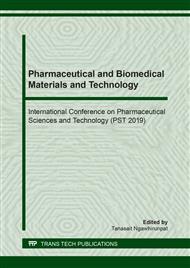p.118
p.124
p.130
p.139
p.145
p.151
p.157
p.163
p.169
Dual-Charge Nanofiber Mats Made of Chitosan(CS)/Poly(Vinyl Alcohol) (PVA) and Poly-(Acrylic Acid-Co-Maleic Acid) (PAMA)/PVA
Abstract:
Nanofibers have been widely used for tissue engineering. Using charged polymers for the preparation of nanofibers can be useful for the loading of substances or macromolecules. Dual charge nanofiber mats are expected to be able to immobilize both positively charged and negatively charged substances in one versatile nanofiber mat. The purpose of this study was to prepare and characterize dual-charge nanofibers generated from poly (vinyl alcohol) (PVA)/poly-(acrylic acid-co-maleic acid) (PAMA) and chitosan (CS)/PVA. The polymer solutions of PAMA/PVA (1:1.63 w/w) and CS/PVA (1:2.33 w/w) were electrospun to form the nanofibers using dual-jet electrospinning process. The obtained dual-charge nanofibers were thermally crosslinked by leaving the nanofibers in the oven at 110-130 °C for 0.5, 1, 3, 5 h. The appearance of the nanofiber mat was characterized by a scanning electron microscope (SEM), and the diameter of nanofibers were determined by an image analysis software (J-micro vision®). The percentage water insolubilization and FT-IR spectra were also determined. The dual-size nanofiber mats with smooth and bead-free fibers were obtained. The diameter of the PAMA/PVA and CS/PVA fibers was 574.54 ± 142.98 nm and 225.69 ± 41.92 nm, respectively. The desirable temperature and time for the crosslink of the dual-charge nanofiber mats was 130 °C for 1 h which could provide a high insolubilization with water capacity of 93.22 ± 2.23%.
Info:
Periodical:
Pages:
145-150
Citation:
Online since:
August 2019
Keywords:
Price:
Сopyright:
© 2019 Trans Tech Publications Ltd. All Rights Reserved
Share:
Citation:


